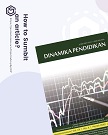E-Learning Adoption; How Is Students Behavior During The Covid-19 Pandemic?
(1) Pendidikan Ekonomi, Fakultas Ekonomi Universitas Negeri Semarang
(2) Universitas Negeri Semarang
Abstract
Keywords
Full Text:
PDFReferences
Adov, L., Pedaste, M., Leijen, A., & Rannikmae, M. (2020). Does It Have to Be Easy, Useful, Or Do We Need Something Else? STEM Teachers’ Attitudes Towards Mobile Device Use in Teaching. Technology, Pedagogy and Education, 29(4), 511-526.
Ain, N., Kaur, K., & Waheed, M. (2016). The Influence of Learning Value on Learning Management System Use: An Extension of UTAUT 2. Information Development, 32(5), 1306-1321.
Alalwan, A. A., Dwivedi, Y. K., & Rana, N. P. (2017). Factors Influencing Adoption of Mobile Banking by Jordanian Bank Customers: Extending UTAUT 2 with trust. International Journal of Information Management, 37(3), 99-110.
Alalwan, A. A., Dwivedi, Y. K., and Williams, M. D. (2016). Customers’ Intention and Adoption of Telebanking in Jordan. Information Systems Management, 33 (2), 154- 178.
Alalwan, A., Dwivedi, Y.K. and Williams, M.D. (2014). Examining Factors Affecting Customer Intention and Adoption of Internet Banking in Jordan. Proceedings of United Kingdom Academy of Information Systems UKAIS Conference, (p.3)
Alshehri, A., Rutter, M. J., & Smith, S. (2019). An Implementation of The UTAUT Model for Understanding Students' Perceptions of Learning Management Systems: A Study Within Tertiary Institutions in Saudi Arabia. International Journal of Distance Education Technologies (IJDET), 17(3), 1-24.
Al-Zoubi SI & Ali M. (2019). E-mobile acceptance using Unified Theory of Acceptance and Use of Technology (UTAUT): research on Universities in Jordan. Ann Emerg Technol Comput (AETiC). 3(4), 28–36.
Baabdullah, A.M. (2018). Factors Influencing Adoption of Mobile Social Network Games (M-SNGs): The Role of Awareness. Information Systems Frontiers, pp. 1-17. 10.1007/s10796-018-9868-1.
Baber, H. (2021). Social Interaction and Effectiveness of The Online Learning–A Moderating Role of Maintaining Social Distance During the Pandemic COVID-19. Asian Education and Development Studies.
Bakar, A. A., Razak, F. Z. A., & Abdullah, W. S. W. (2013). Assessing The Effects of UTAUT And Self-Determination Predictor on Students Continuance Intention to Use Student Portal. World Applied Sciences Journal, 21(10), 1484-1489.
Batoro, B. (2020). Evaluation Factors Influencing the Use of Go-Pay with the Unified Theory of Acceptance and Use of Technology 2 Model. In 1st Annual Management, Business and Economic Conference (AMBEC). 211-214.
Brown, S. A., Dennis, A. R., & Venkatesh, V. (2010). Predicting Collaboration Technology Use: Integrating Technology Adoption and Collaboration Research. Journal of management information systems, 27(2), 9-54.
Chao C-M. (2019). Factors Determining The Behavioral Intention To Use Mobile Learning: An Application and Extension of The UTAUT Model. Front Psychol.10, 1652.
Chau, A., Stephens, G., & Jamieson, R. (2014). Biometrics acceptance-perceptions of use of biometrics. ACIS 2004 Proceedings, 28.
Chong, A. Y. L. (2013). Predicting M-Commerce Adoption Determinants: A Neural Network Approach. Expert Systems with Applications, 40(2), 523-530.
Chua, P.Y., Rezaei, S., Gu, M.-L., Oh, Y. and Jambulingam, M. (2018). Elucidating Social Networking Apps Decisions: Performance Expectancy, Effort Expectancy and Social Influence. Nankai Business Review International. 9(2), 118-142.
Ezzaouia, I., & Bulchand-Gidumal, J. (2021). A Model to Predict Users’ Intentions To Adopt Contact-Tracing Apps For Prevention From COVID-19. In Information and Communication Technologies in Tourism. 543-548.
Fagan, M. H. (2019). Factors influencing student acceptance of mobile learning in higher education. Computers in the Schools, 36(2), 105-121.
Gunasinghe, A., Abd Hamid, J., Khatibi, A., & Azam, S. F. (2019). The adequacy of UTAUT-3 in interpreting academician’s adoption to e-Learning in higher education environments. Interactive Technology and Smart Education.
Gupta, K., & Arora, N. (2019). Investigating consumer intention to accept mobile payment systems through unified theory of acceptance model. South Asian Journal of Business Studies.
Hew, J. J., Lee, V. H., Ooi, K. B., & Wei, J. (2015). What Catalyses Mobile Apps Usage Intention: An Empirical Analysis. Industrial Management & Data Systems.
Jayanth J. A & Murugan P. (2020). Examining the inter-relationships of UTAUT Constructs in Mobile Internet Use in India and Germany. J Electron Commer Organ. 18(2): 36–48.
Kang, M., Liew, B. Y. T., Lim, H., Jang, J., & Lee, S. (2015). Investigating the determinants of mobile learning acceptance in Korea using UTAUT2. In Emerging Issues in Smart Learning. 209-216.
Kim J, & Lee KS. (2020). Conceptual Model To Predict Filipino Teachers’ Adoption Of ICT- Based Instruction In Class: Using The UTAUT Model. Asia Pac J Educ. 1-15
Kwateng, K. O., Atiemo, K. A. O., & Appiah, C. (2019). Acceptance and use of mobile banking: an application of UTAUT2. Journal of Enterprise Information Management.
Lin, J. W., & Lai, Y. C. (2019). User acceptance model of computer-based assessment: moderating effect and intention-behavior effect. Australasian Journal of Educational Technology, 35(1).
Mittal, A., Mantri, A., Tandon, U., & Dwivedi, Y. K. (2021). A unified perspective on the adoption of online teaching in higher education during the COVID-19pandemic. Information Discovery and Delivery.
Morosan, C., & DeFranco, A. (2016). It's about time: Revisiting UTAUT2 to examine consumers’ intentions to use NFC mobile payments in hotels. International Journal of Hospitality Management, 53, 17-29.
Muthuprasad, T., Aiswarya, S., Aditya, K. S., & Jha, G. K. (2021). Students’ perception and preference for online education in India during COVID-19pandemic. Social Sciences & Humanities Open, 3(1).
Nikolopoulou, K., Gialamas, V., & Lavidas, K. (2020). Acceptance of Mobile Phone by University Students for Their Studies: An Investigation Applying UTAUT2 Model. Education and Information Technologies, 25(5), 4139-4155.
Oliveira, T., Thomas, M., Baptista, G. and Campos, F. (2016). Mobile payment: understanding the determinants of customer adoption and intention to recommend the technology. Computers in Human Behavior, 61, 404-414.
Omar M-N, Noor S, Kasim A-L. (2019). The influence of mobile technology adoption among secondary school teachers using the UTAUT2 model. Int J Recent Technol Eng. 8(4), 3827-31.
Purwanto, E., & Loisa, J. (2020). The intention and use behaviour of the mobile banking system in Indonesia: UTAUT Model. Technology Reports of Kansai University, 62(06), 2757-2767.
Rahman, F. B. A., Hanafiah, M. H. M., Zahari, M. S. M., & Jipiu, L. B. (2021). Systematic Literature Review on The Evolution of Technology Acceptance and Usage Model used in Consumer Behavioural Study. International Journal of Academic Research in Business and Social Sciences, 11(13), 272– 298.
Ramirez-Correa, Patricio., RondánCataluñab, Francisco Javier., Arenas- Gaitánb, Jorge. and Martín-Velicia, Félix. (2019). Analysing the acceptation of online games in mobile devices: An application of UTAUT2. Journal of Retailing and Consumer Services, Elsevier, 50, 85-93
Salloum, S. A., & Shaalan, K. (2018). Factors affecting students’ acceptance of e-learning system in higher education using UTAUT and structural equation modeling approaches. In International Conference on Advanced Intelligent Systems and Informatics, 469-480.
Samsudeen, S. N., & Mohamed, R. (2019). University students’ intention to use e-learning systems. Interactive Technology and Smart Education.
Sezgin, E., and S. O. Y Ildirim. (2016). Trends of factors and theories in health information systems acceptance: 2002–2014 review. In Encyclopedia of E-health and telemedicine, 1085–104.
Sidik D, and Syafar F. (2020) Exploring the factors influencing students’ intention to use mobile learning in Indonesia higher education. Educ Inform Technol, 25(4).
Slade, E., Williams, M., Dwivedi, Y. and Piercy, N. (2015). Exploring consumer adoption of proximity mobile payments. Journal of Strategic Marketing. 23(3), 209-223.
Syafri, F., & Rafli, Z. (2019). The Calla-Based Elena Model for Linguistics: Does It Work? IJLECR-International Journal of Language Education and Culture Review, 5(2), 153-165.
Tak, P., & Panwar, S. (2017). Using UTAUT 2 model to predict mobile appbased shopping: evidences from India. Journal of Indian Business Research.
Tan, P. J. B. (2013). Applying the UTAUT to understand factors affecting the use of English e-learning websites in Taiwan. Sage Open, 3(4).
Tarhini, A., Alalwan, A. A., Shammout, A. B., & Al-Badi, A. (2019). An analysis of the factors affecting mobile commerce adoption in developing countries. Review of International Business and Strategy.
Tarhini, A., Al-Busaidi, K. A., Mohammed, A. B., & Maqableh, M. (2017). Factors influencing students’ adoption of e-learning: a structural equation modeling approach. Journal of International Education in Business.
Tarhini, A., Arachchilage, N. A. G., & Abbasi, M. S. (2015). A critical review of theories and models of technology adoption and acceptance in information system research. International Journal of Technology Diffusion (IJTD), 6(4), 58-77.
Venkatesh, V., Morris, M.G., Davis, G.B. and Davis, F.D. (2003). User acceptance of information technology: toward a unified view. MIS Quarterly, Vol. 27 No. 3, pp. 425-478.
Venkatesh, V., Thong, J. Y., & Xu, X. (2012). Consumer acceptance and use of information technology: extending the unified theory of acceptance and use of technology. MIS quarterly, 157-178.
Wardoyo, C. (2016). Developing Learning Media Based on E-Learning on Accounting Subject for Senior High School Students. Dinamika Pendidikan, 11(2), 84-93. doi:https://doi.org/10.15294/dp.v11i2.8932
Widhiastuti, R., & Yulianto, A. (2017). Analysis of Technology Acceptance Model in Understanding of Students Behavior Intention in Use of Sikadu. Dinamika Pendidikan, 12(1), 20-27. doi:https://doi.org/10.15294/dp.v12i1.10583
Wong S-M, Leong C-M, Puah C-H. (2019). Mobile Internet Adoption In Malaysian Suburbs: The Moderating Effect Of Gender. Asian J Bus Res. 9(3), 90–114.
Yuan, S., Ma, W., Kanthawala, S., &Peng, W. (2015). Keep using my health apps: Discover users' perception of health and fitness apps with the UTAUT2 model. Telemedicine and eHealth, 21(9), 735-741.
Yuvaraj, M. (2016). Adoption of technology in recruitment of library professionals and faculty members: Case study of social media in India. The Bottom Line. 29(4), 241-250.
Refbacks
- There are currently no refbacks.

This work is licensed under a Creative Commons Attribution 4.0 International License.


.png)

.png)





